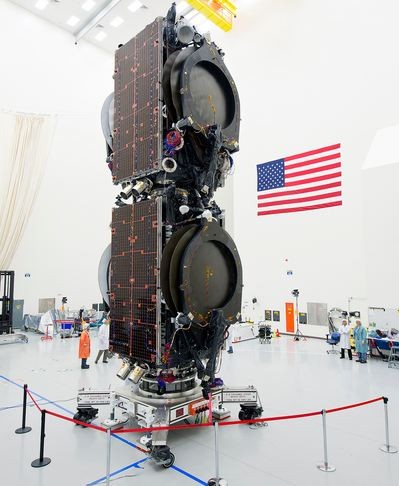World's First 'Electric Satellites' with Ion Engines are Successfully Orbited
| Arthur Dominic Villasanta | | Mar 02, 2015 05:05 AM EST |
(Photo : SpaceX) Electric satellites ABS 3A and Eutelsat 115 B West stacked on top of each other prior to launch.
The world's first commercial satellites powered by xenon-ion electric engines were successfully orbited March 1.
A SpaceX Falcon 9 rocket launched two "electric satellites" equipped with revolutionary xenon-ion engines that turn gas into a propellant from the Cape Canaveral Air Force Station in Florida.
Like Us on Facebook
The all-electric propulsion satellites are Eutelsat 115 West B and ABS 3A. These birds will provide internet connectivity and telecommunications throughout the world from geosynchronous orbits 35,800 kilometers above the planet.
The satellite bus or body of both satellites is the new and lightweight Boeing 702SP. Eutelsat 115 West B and ABS 3A are the first two Boeing 702SP satellites placed in orbit.
This bus differs from other communications satellite platforms because it doesn't have a large fuel tank that carries the fuel for station keeping operations and is the key component of most satellites. The electric engines on the Boeing 702SP will allow the satellites to perform station keeping operations for up to two decades, which is about five years longer than conventional satellites.
The fuel tanks in most satellites carry a supply of conventional liquid hydrazine fuel (an extremely toxic substance) to maintain their orbital positions. Over half the weight in most communications satellites is accounted for by station-keeping fuel.
Some satellites, especially the large satellites in geosynchronous orbit, carry up to 5,000 pounds of liquid propellant for station keeping maneuvers that keep satellites within their designated orbital slots.
Without the need for liquid fuel, Eutelsat 115 West B and ABS 3A weighs less than 5,000 pounds. A spacecraft with capabilities comparable to the Boeing 702SP would weigh over 8,000 pounds without the all-electric propulsion system.
The innovation of the Boeing 702SP and its electric engines allows satellite operators to order smaller spacecraft that can host extra communications capacity to replace the mass freed up with the removal of the fuel tanks, said Mark Spiwak, president of Boeing Satellite Systems International.
"One of the big drivers was cost," Spiwak said. "We're able to get the launch cost significantly reduced, get more payload mass to orbit, and reduce the overall cycle time of (building each satellite)."
Large satellites built by Boeing and other companies have used electric propulsion before, but the spacecraft have always carried chemical rocket fuel to supplement their ion engines.
Spiwak also said that with the reduced weight at launch, two lighter payloads can ride into orbit together on SpaceX's Falcon 9 rocket, which can normally only loft one large telecommunications satellite at a time.
"Going to an all-electric system, you're able to reduce the fuel load by almost a factor of 10," said Mike Connelly, director of Boeing's product line for the new 702SP platform.. "That fuel load reduction allowed us to stack the satellites on top of each other, and give the customers a two-for-one deal on the launch costs."
Eutelsat and ABS paid less than $30 million apiece to launch their satellites on the Falcon 9. Such a low price for the launch of a communications satellite is "almost unheard of," according satellite industry experts.
ABS 3A, the lighter of the two satellites, should reach geosynchronous orbit 22,300 miles over the equator by the end of August. The Eutelsat 115 West B spacecraft will take a few weeks longer because it weighs more.
The satellites can accommodate over 700 pounds of xenon, which the xenon-ion engines use to create thrust by accelerating the xenon ions.
©2015 Chinatopix All rights reserved. Do not reproduce without permission
EDITOR'S PICKS
-

Did the Trump administration just announce plans for a trade war with ‘hostile’ China and Russia?
-

US Senate passes Taiwan travel bill slammed by China
-

As Yan Sihong’s family grieves, here are other Chinese students who went missing abroad. Some have never been found
-

Beijing blasts Western critics who ‘smear China’ with the term sharp power
-

China Envoy Seeks to Defuse Tensions With U.S. as a Trade War Brews
-

Singapore's Deputy PM Provides Bitcoin Vote of Confidence Amid China's Blanket Bans
-

China warns investors over risks in overseas virtual currency trading
-

Chinese government most trustworthy: survey
-

Kashima Antlers On Course For Back-To-Back Titles
MOST POPULAR
LATEST NEWS
Zhou Yongkang: China's Former Security Chief Sentenced to Life in Prison

China's former Chief of the Ministry of Public Security, Zhou Yongkang, has been given a life sentence after he was found guilty of abusing his office, bribery and deliberately ... Full Article
TRENDING STORY

China Pork Prices Expected to Stabilize As The Supplies Recover

Elephone P9000 Smartphone is now on Sale on Amazon India

There's a Big Chance Cliffhangers Won't Still Be Resolved When Grey's Anatomy Season 13 Returns

Supreme Court Ruled on Samsung vs Apple Dispute for Patent Infringement

Microsoft Surface Pro 5 Rumors and Release Date: What is the Latest?










